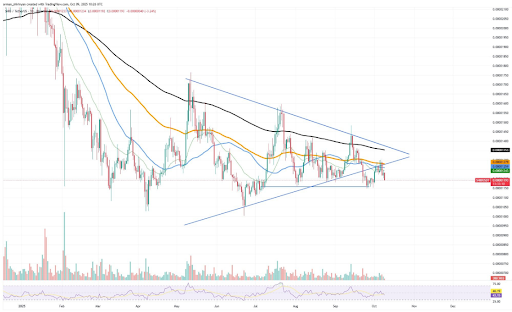- Over 142 billion SHIB tokens worth millions exited exchanges, causing a steep drop in liquidity and signaling cautious market sentiment.
- Despite lower exchange supply, weak demand and fading participation have kept SHIB’s technical outlook under persistent pressure.
- Reduced liquidity has increased market fragility, where small sell-offs could amplify volatility and weigh on price stability.
Shiba Inu has recorded a steep contraction in liquidity following a substantial outflow of tokens from exchanges. Over 142 billion SHIB, valued in millions, were withdrawn within the past 24 hours, marking one of the largest single-day declines in recent months. The movement indicates that many traders are either transferring holdings to cold storage or exiting the market entirely.
The recent exodus has left the SHIB market divided between optimism and concern. Large withdrawals from exchanges are often viewed as a bullish signal because they suggest a reduced likelihood of immediate selling. Fewer tokens available for trading can lessen selling pressure and help stabilize prices. However, in this case, the withdrawals coincide with weakening demand and growing market caution.
Weak Technical Indicators Add to Pressure
SHIB’s price continues to hover near $0.0000119, a level that has tested investor confidence. The token has yet to reclaim key moving averages, while trading volumes remain subdued. Market participation has declined steadily, reflecting reduced enthusiasm among traders. Moreover, the relative strength index remains neutral, showing little evidence of renewed momentum.

Despite lower supply on exchanges, the absence of strong buying activity has created fragile market conditions. Even moderate sell-offs could trigger exaggerated price swings due to the thinning liquidity. This environment leaves SHIB vulnerable to volatility, especially if investor sentiment deteriorates further.
Broader Market Context Suggests Ongoing Strain
The liquidity contraction aligns with a broader cooling trend across the altcoin sector, where reduced volumes have mirrored a cautious trading atmosphere. While lower exchange balances might curb immediate selling, the sustained lack of institutional or retail demand prevents SHIB from building a solid price foundation.
Consequently, while the outflows have eased short-term selling pressure, they have not strengthened market fundamentals. Unless trading volumes recover and new demand emerges, Shiba Inu’s liquidity challenges could persist, maintaining pressure on the token’s price structure and overall market stability.








